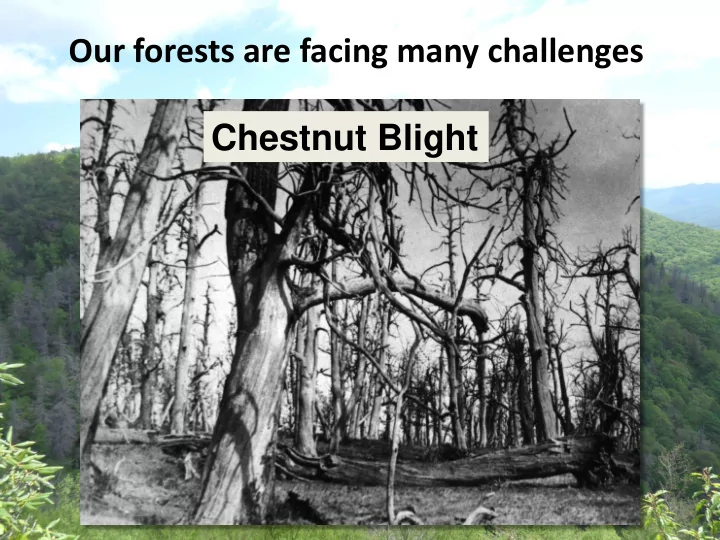

Our forests are facing many challenges Chestnut Blight
How a single gene may help save the American Chestnut Andy Newhouse (PhD grad student) Current research team: Tyler Desmarais (MS grad student) Bill Powell (Director) Dakota Matthews (MS grad student) Chuck Maynard (Co-Director Emeritus) Vern Coffey (MS grad student) Linda McGuigan (TC lab Manager) Yoks Bathula (MS grad student) Allison Oakes (Post doctoral fellow) Xueqing Xiong (MS grad student) Kaitlin Breda (Admin assistant) Erik Carlson (MS grad student) Andrew Teller (Research Analyst) Hannah Pilkey (MS grad student) Many undergrads, high school students, collaborators, and many volunteers… The work of well over 100 people over the years 2
Wood products Agricultural Social/historical Chestnuts roasting on an open fire, The Christmas Song ( by Torme and Wells in 1946)
Keystone forest species (environmental benefits)
Restoration of the American chestnut may benefit many endangered species Carolina northern flying squirrel More mast, more rodents, supports ( Glaucomys sabrinus ) American burying beetle Small Whorled Pogonia, Isotria medeoloides, Habitat promoted by American chestnut American chestnut was predominant before these species were endangered
American chestnut tree had diverse forms photo in MI, 1980s by Alan D. Hart Forest History Society
Chestnut blight in the U.S. Chestnut blight on related species: ~50 years spread through natural range Allegheny Chinkapin, C. pumila var. pumila killing ~4 billion American chestnut trees Ozark Chinquapin, C. pumila var. ozarkensis In 1904, discovery of chestnut blight in the Bronx Zoo (Merkel) Chestnut blight also survives on oaks
Spring 1912
1912 photo of blight in NY
After over a century of unsuccessful attempts at combating the blight, what are the choices for restoration? Chestnut f1 hybrids are OK for ornamentals or crops, Not for restoration Japanese chestnut C. crenata Chinese chestnut American chestnut C. dentata C. mollissima European chestnut C. sativa
Are hybrids suitable for restoration? Unlikely to replace the American chestnut Lion: Panthera leo Tiger: Panthera tigris American chestnut Castanea dentata (canopy tree) Chinese chestnut Liger: Panthera hybrid Castanea mollissima (orchard tree) Better ways:
~38,000 CC genes + ~38,000 AC genes Unwanted traits TACF Meadowview Farm, VA Dr. Fred Hebard Unwanted traits (started 1983) Dr. Jared Westbrook (current) Unwanted traits Goal is for 1/16 What if you Chinese chestnut didn’t have to genome to contain select out any the required 3 to 6 unwanted more blight traits? resistance loci (#genes?)
Breeding & Transgenics: (Both viable options & both have advantages & disadvantages) Chestnut has ~ 38,000 gene pairs 1/16 Chinese chestnut genes: CC AC 10 pages or 2,375 words It was very exciting at that season to roam the blight resistant then boundless chestnut Making very small woods of Lincoln, … changes, adding Henry David Thoreau, “ Walden: or Life in the Woods, ” 1899 only 2 words 100% American chestnut + blight resistance
What genes do we test? Forest Health Initiative grant: Asian species Quantitative resistance, therefore requires multiple genes: Possibilities so far out of 28 being tested: 1. Acid phosphatase ( C. mollissima ) 2. Laccase-like protein ( C. mollissima ) 3. Lipid transfer protein ( C. mollissima ) 4. Cystatin ( C. mollissima ) 5. Glutathione s-transferase ( C. mollissima ) 6. Deoxy-arabino-heptulosonate phosphate synthase ( C. mollissima ) 7. Subtilisin-like protease ( C. seguinii ) Remember, it is not the source of the gene that is important, it is the function of the gene that is key. Or other plants? stilbene synthase (grape) – phytoalexins like resveratrol (Dr. Joe Nairn, UGA) oxalate oxidase (wheat and many other plants) (Dr. Randy Allen, Texas Tech)
Oxalate oxidase (OxO) from wheat ubiquitous enzyme in many plants & fungi (non-gluten enzyme) Wheat Goatgrass Rice Stiff brome Barley Wild einkorn Sorghum Perennial Banana ryegrass Oil palm Castor bean Date palm Insulin plant Barrel clover Spiny amaranth Strawberry Azalea Beet Mosses (6 spp.) Cacao Fungi Peanut Peach & Apricot
Oxalate oxidase (OxO) from wheat ubiquitous enzyme in many plants & fungi (non-gluten enzyme) Detoxifies oxalate (oxalic acid) Not a pesticide (more like an antitoxin) Does not kill the fungus, no ‘ cidal ’ activity. Since the fungus survives, less selective pressure to overcome the oxalate oxidase. On transgenic American chestnut, changes the fungal lifestyle from a pathogen to a saprophyte (coexist). (like on Chinese chestnut & some oaks)
How do we get the gene in? How do we test for blight resistance?
Coexistence of C. parasitica and chestnut trees Therefore, the tree tolerates the fungus The fungus survives on American chestnut similar to Chinese chestnut
Inheritance of blight tolerance Pollination with transgenic pollen
Darling 311 T1 Seedling Full Sibling Control OxO Transgenic American Non-Transgenic American Chestnut Chestnut Photographed 13 weeks after inoculation with C. parasitica strain EP155
Federal regulatory review: Voluntary - Registration? Non-regulated status No further questions New paradigm for regulators
Many typical comparative studies, plus additional experiments for restoration trees (slide by Andy Newhouse)
A unique opportunity with the Darling lines of blight resistant American chestnut: Rescuing the surviving genetic diversity. 18 in. DBH American chestnut Manlius, NY
Unique feature of the ‘Darling’ American chestnut trees: Rescuing genotypes surviving trees Supplier of pollen T1 Genotypes Regionally ½ mother & ½ father adapted Parental allelic pollen seed composition Continue to maximize out-crossing Allows: Transgenic Allelic rescue, American local adaptation, chestnut and increases genetic diversity TACF conservation orchards Offspring Or surviving wild population 50% OxO & fully blight resistance Or backcross trees 26
Applications to forest health Need to take a holistic approach Pest or Pathogen destroys the trees Containment procedures buying time Rescue genetic Genetic engineering diversity & breeding Early development of pest & pathogen resistant trees for restoration
"We humans are more than consumers, we have gifts of our own to give to the earth." Dr. Kimmerer at the U.N. Questions?
Recommend
More recommend